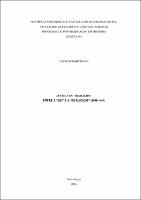| Compartilhe o registro |


|
Use este identificador para citar ou linkar para este item:
https://tede2.pucrs.br/tede2/handle/tede/2494Registro completo de metadados
| Campo DC | Valor | Idioma |
|---|---|---|
| dc.creator | Bartmann, Tatiane | - |
| dc.creator.Lattes | http://buscatextual.cnpq.br/buscatextual/visualizacv.do?id=K4446928Y6 | por |
| dc.contributor.advisor1 | Abreu, Luciano Aronne de | - |
| dc.contributor.advisor1Lattes | http://buscatextual.cnpq.br/buscatextual/visualizacv.do?id=K4264544H3 | por |
| dc.date.accessioned | 2015-04-14T13:48:12Z | - |
| dc.date.available | 2014-04-22 | - |
| dc.date.issued | 2014-03-28 | - |
| dc.identifier.citation | BARTMANN, Tatiane. Justiça do trabalho : entre a lei e a realidade (1941-1945). 2014. 184 f. Dissertação (Mestrado em História) - Pontifícia Universidade Católica do Rio Grande do Sul, Porto Alegre, 2014. | por |
| dc.identifier.uri | http://tede2.pucrs.br/tede2/handle/tede/2494 | - |
| dc.description.resumo | A presente pesquisa objetiva analisar as relações de trabalho nas empresas fundadoras do Centro da Indústria Fabril do Rio Grande do Sul (Cinfa) e a atuação mediadora da Justiça do Trabalho conciliando ou julgando os processos trabalhistas movidos pelos empregados desses estabelecimentos. A investigação ocorre por meio dos processos trabalhistas individuais que tramitaram na 1ª Junta de Conciliação e Julgamento de Porto Alegre (1ª JCJ), órgão de primeira instância da Justiça do Trabalho, desde o ano de sua instalação (1941) até o final do Estado Novo (1945). Trata-se, portanto, do período inicial de organização e funcionamento da JT, uma espécie de tribunal administrativo do trabalho que goza de relativa autonomia devido a sua vinculação ao Poder Executivo. Seguindo a metodologia da análise de conteúdo, as ações individuais impetradas pelos trabalhadores contra as indústrias fundadoras da associação empresarial foram ordenadas e agrupadas em categorias temáticas através da análise das reclamações dos empregados. Trata-se de quatro categorias elaboradas: Rescisão Contratual, Suspensão Disciplinar, Condições de Trabalho e Rebaixamento de Salário. A partir da análise destas categorias, são verificadas as reclamações mais frequentes dos trabalhadores que, de modo geral, reivindicam pelo cumprimento da legislação trabalhista, compreendendo as leis e a justiça como um conjunto de códigos e atribuições legais. Diante disso, compete a 1ª JCJ dirimir os conflitos entre empregados e empregadores, interpretando as leis e considerando a realidade prática dos trabalhadores, ou seja, atuando entre a lei e a realidade. | por |
| dc.description.abstract | The following research aims to analyze the relationships of labor in the founding companies of Centro da Indústria Fabril do Rio Grande do Sul (Cinfa) and the mediator role of the Labor Court reconciling or judging labor suits claimed by employees of these establishments. The investigation occurred by analyzing labor cases brought forward by individual employees that were, at the time, analyzed at the 1ª Junta de Conciliação e Julgamento de Porto Alegre (1ª JCJ - the first instance of court regarding labor law) since the year of its opening (1941) until the end of the Estado Novo (1945). Therefore, it addresses the starting period of the organization and functioning of the JT, a type of managed court of labor law that is provided certain autonomy due to having ties to the Executive Power. Following the methodology of content analysis, the individual lawsuits brought by workers against the founding industries of the business association were sorted and grouped into categories divided by themes through the analysis of the complaints of the employees. By doing so, four categories were elaborated: "Contract Termination", "Disciplinary Suspension", "Working Conditions" and "Salary Reduction". From the analysis of these categories, the most frequent complaints made by workers were verified and they, in general, demanded the enforcement of labor legislation comprising laws and justice as a set of codes and legal duties. Thus, it falls to the 1ª JCJ to settle the conflicts between employees and employers by interpreting laws and considering the practical reality of workers, acting between the law and reality. | eng |
| dc.description.provenance | Made available in DSpace on 2015-04-14T13:48:12Z (GMT). No. of bitstreams: 1 457144.pdf: 1218759 bytes, checksum: d17223f1ae8558c410eec85f8abf16de (MD5) Previous issue date: 2014-03-28 | eng |
| dc.format | application/pdf | por |
| dc.thumbnail.url | http://tede2.pucrs.br:80/tede2/retrieve/10875/457144.pdf.jpg | * |
| dc.language | por | por |
| dc.publisher | Pontifícia Universidade Católica do Rio Grande do Sul | por |
| dc.publisher.department | Faculdade de Filosofia e Ciências Humanas | por |
| dc.publisher.country | BR | por |
| dc.publisher.initials | PUCRS | por |
| dc.publisher.program | Programa de Pós-Graduação em História | por |
| dc.rights | Acesso Aberto | por |
| dc.subject | DIREITO DO TRABALHO | por |
| dc.subject | JUSTIÇA DO TRABALHO - BRASIL | por |
| dc.subject | INDÚSTRIAS - BRASIL | por |
| dc.subject.cnpq | CNPQ::CIENCIAS HUMANAS::HISTORIA | por |
| dc.title | Justiça do trabalho : entre a lei e a realidade (1941-1945) | por |
| dc.type | Dissertação | por |
| Aparece nas coleções: | Programa de Pós-Graduação em História | |
Arquivos associados a este item:
| Arquivo | Descrição | Tamanho | Formato | |
|---|---|---|---|---|
| 457144.pdf | Texto Completo | 1,19 MB | Adobe PDF |  Baixar/Abrir Pré-Visualizar |
Os itens no repositório estão protegidos por copyright, com todos os direitos reservados, salvo quando é indicado o contrário.




